 When I trained as a youngster with the local athletics club the Coach had a stopwatch but none of us young athletes wore a watch. If we owned a watch, it’s only functions would have been to tell us the time and perhaps the date. It would have certainly been taken it off prior to the run. When we raced we would run as hard as we could for the distance; so if it was a 3 mile XC race we would race as fast as we could for 3 miles when we conducted a training session each interval was as fast as we could for the number of yards (yes it was yards back in the day) that the coach set.
In the mid-1990s I did buy my first heart rate monitor and for full disclosure I do own a GPS watch. I no longer use the former and I do find the latter useful for some racing and in particular to hold my pace in the first few miles (yes even I go off too hard at times) if I am trying to even pace a race. I will also use the time facility if I am doing a timed fartlek or interval session and would use the GPS if I wanted to run a particular distance or a particular pace. However the absolute majority of my runs are conducted with no watch, no HRM and no GPS.
When I trained as a youngster with the local athletics club the Coach had a stopwatch but none of us young athletes wore a watch. If we owned a watch, it’s only functions would have been to tell us the time and perhaps the date. It would have certainly been taken it off prior to the run. When we raced we would run as hard as we could for the distance; so if it was a 3 mile XC race we would race as fast as we could for 3 miles when we conducted a training session each interval was as fast as we could for the number of yards (yes it was yards back in the day) that the coach set.
In the mid-1990s I did buy my first heart rate monitor and for full disclosure I do own a GPS watch. I no longer use the former and I do find the latter useful for some racing and in particular to hold my pace in the first few miles (yes even I go off too hard at times) if I am trying to even pace a race. I will also use the time facility if I am doing a timed fartlek or interval session and would use the GPS if I wanted to run a particular distance or a particular pace. However the absolute majority of my runs are conducted with no watch, no HRM and no GPS.
This morning’s run was a good example, I wanted to run about an hour at an easy pace with my Collie, Murphy but to be honest if it was 55 minutes or 65 minutes or it was 7:30 pace or 8:30 pace it didn’t matter as long as it felt easy. So I picked a route that I knew would take about an hour an off we went. Running this way will allow you to truly understand your body and understand how running at particular intensities actually feels.
 This week in Athletics Weekly, Julia Bleasdale the British 10,000m runner was interviewed and stated that she too enjoys leaving the watch behind. Rather than paraphrase what Julia said I will quote it and if you want to read the full article please buy Athletics Weekly.
This week in Athletics Weekly, Julia Bleasdale the British 10,000m runner was interviewed and stated that she too enjoys leaving the watch behind. Rather than paraphrase what Julia said I will quote it and if you want to read the full article please buy Athletics Weekly.
“With the training aids nowadays giving you your pace and distance, when you run along with your watch, you’re always going to have an emotional response,” she says. “Sometimes in training I don’t take a watch and I feel I’ve become very in tune with my body. I can sense whether I’m running at the right intensity but only by starting the process of sometimes leaving your watch behind can develop that real deeper self-awareness and having that self-awareness can really help athletes to get closer to fulfilling their potential because you’re really in tune with your body, sensing niggles and how hard to push rather than trying to fulfil what a piece of paper or your training aid is telling you.”
An interesting area here is that Julia talks about having an ‘emotional response’ when running with a GPS and as a Coach I believe that sometimes athletes will set a false ceiling. They may be going well and look at their GPS and think ‘I can’t run this fast’ and slow down. In some respects this may be the correct response as they may have actually gone off way too hard however on the other hand they may be having a breakthrough performance and should carry on. Again if they have conducted training without a watch then they will know whether they are going too hard. Regardless what your gadget is telling you if you feel like you are going too easy or too hard then you probably are.
So like Julia I would encourage you to start to leave the watch at home for some of your runs and begin to develop that self-awareness and sense the intensity you are running at.
Let us know how you get on.
